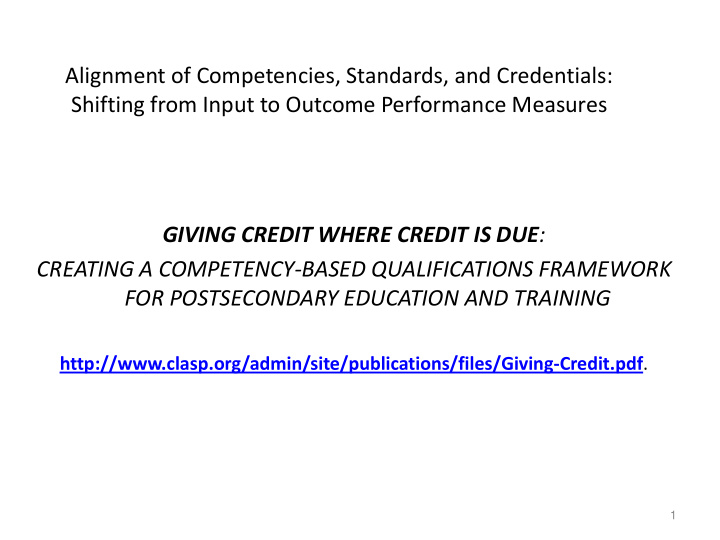



Alignment of Competencies, Standards, and Credentials: Shifting from Input to Outcome Performance Measures GIVING CREDIT WHERE CREDIT IS DUE : CREATING A COMPETENCY-BASED QUALIFICATIONS FRAMEWORK FOR POSTSECONDARY EDUCATION AND TRAINING http://www.clasp.org/admin/site/publications/files/Giving-Credit.pdf . 1
Why Credentials Matter… “We will never be able to clean up the general mess of the American labor market without a stronger commitment to credentials and a system of common standards that supports them. A competency based credentials system reduces employer search and transaction costs, increases worker security, and can guarantee quality work and quality jobs” (Greener Skills: How Credentials Create Value in the Clean Energy Economy, Center on Wisconsin Strategy, 2010) 3
Credentialing System in the United States
What is needed? • The right competencies being taught to the standards set by employers • Students able to consistently demonstrate that they have the competencies • Effective assessment of competencies regardless of where and how they are learned • A credential that reliably communicates to employers that students/workers have the competencies they need to be successful in the labor market • Changing the unit of analysis for education to performance measures (Student Success, Learning and Employment Gains)
Disconnects… • Between employers and educators Different perspectives on the priorities of postsecondary education in preparing students for the workforce The current credentialing system is confusing to employers, institutions, labor market service providers and students • Between postsecondary education, public workforce systems and other education partners • “Seat time” does not equal learning – Learning Outcomes, Competencies and Standards matter • Credit and non-credit learning – A student’s ability to demonstrate his/her learning is what is important 6
The Key Questions… • How do we know we are teaching the competencies required of students in the workplace and in their future career pathways? (Business engagement and standards) • How do we know students can consistently demonstrate what they have learned? • Are credentials portable (industry recognized) across a dynamic labor market? • Are students prepared with both the technical skills and the soft skills to continuously learn and adapt to labor market and technology changes? 7
What Governors Can Do • Spread the message that a “college “ education includes options other than a baccalaureate degree – Technical education (which prepares students for good paying Middle Skills jobs) is a meaningful and important option – Many non-baccalaureate credentials have significant labor market payoff • Establish a limited number of linked goals – Link goals among workforce and economic development and education stakeholders in key measureable metrics and report performance outcomes – For example, X% increase in labor market validated credentials in critical industries • Incent colleges to engage in collaboration and innovation around meeting the workforce needs of critical state sectors – Reward results at the strategic level (“linked goals”), as well as the agency or institutional level 8
What Governors Can Do • Expand linkages between non-credit and credit learning • Work at the leadership and policy level to expand these linkages • Focus on the linkages as they result in increasing career pathways and increased credential attainment (especially for working age adults). • Raise the bar for business engagement – Promote the joint establishment of rigorous competency/ standards/ curricula/ credentials and quality assurance mechanisms between business and education – Challenge employers to share on-going responsibility for a competitive workforce and establishing meaningful curricula and credentials • Increase alignment and linkages between federal, state, and local public workforce systems and educational institutions • Ensure that curricula reflects labor market needs and that students choose the right programs and credentials
What Governors Can Do • Champion the transformation of instructional delivery and professional development at the postsecondary level: • Build “stackable” credentials • Create multiple entry/exit points • Increase contextual and work-based learning • Embed industry certifications in curriculum • Utilize e-learning and technology • Student-centered, interactive learning– to include problem solving, critical thinking, systems thinking, team based learning, etc.
Recommend
More recommend